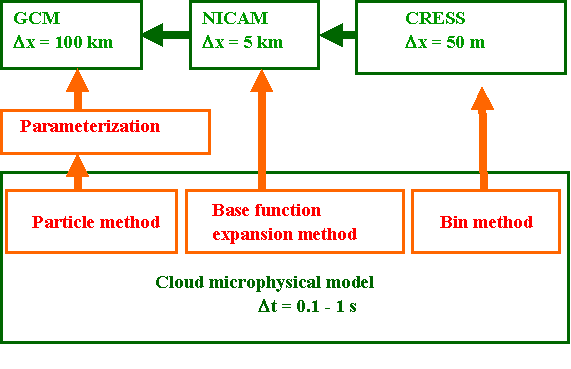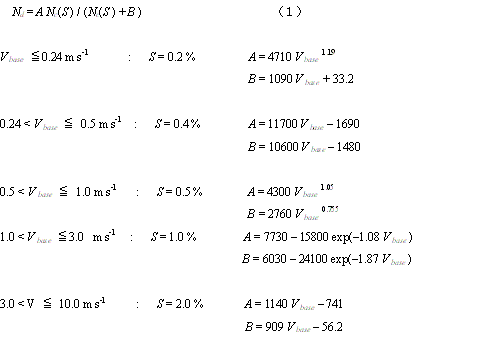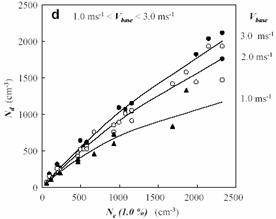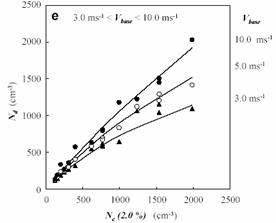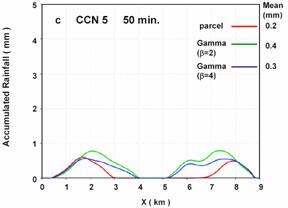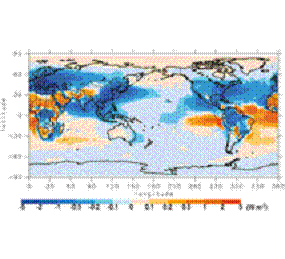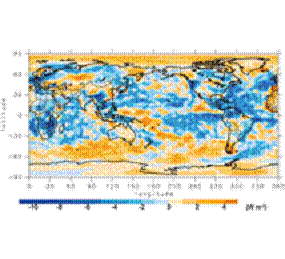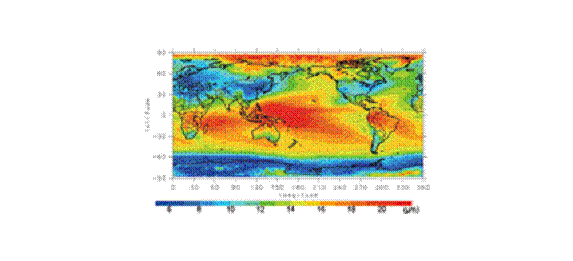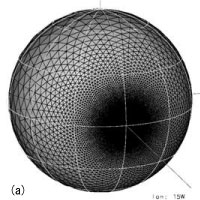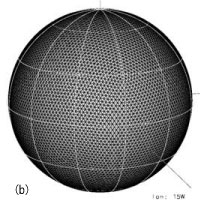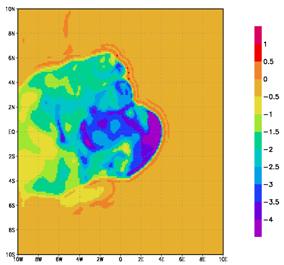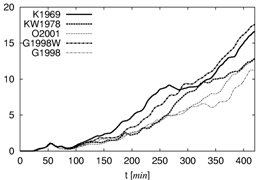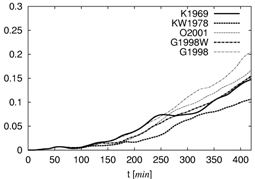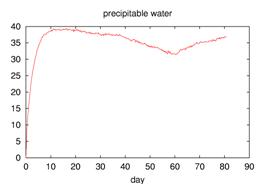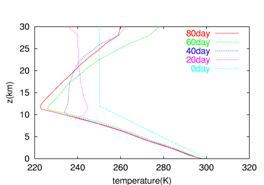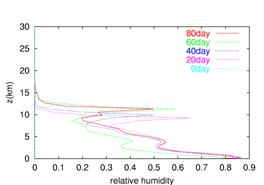2. Warming and atmospheric composition change interaction model developmentResults Page | Top Page |
||||||||||||||||||||||||||||||||||||||||||||||
|
2-2 A warming-cloud, aerosol, and radiation feedback precision evaluation The organization name in charge: Earth frontier research system
a. SummaryThis group's subject is developing parameterization for a general circulation model (GCM) estimating the indirect radiation legal force of the influence aerosol affects the optical characteristic of clouds, i.e., troposhere aerosol. parameterization which evaluates the influence the condensation nucleus (Cloud Condensation Nuclei:CCN) of a cloud particle affects the fine structure of clouds by an earth frontier research system is developed. This parameterization, parameterization of Abdul-Razzak et al. (1998), etc. were taken into CCSR/NIES AGCM with SPRINTARS which is an aerosol climate model, and all ball distribution of the optical thickness of clouds or a cloud particle effective radius was calculated, and it inquired by performing comparison with satellite observational data. Furthermore, in order to make it the effective thing as parameterization for GCM, NICAM (New Icosahediral Atmospheric Model, Satoh, 2003, Tomita, 2002) is used, and the detailed cloud physics model loading super-high resolution all ball model is developed. Furthermore, development of the cloud resolving domain model which carries the bottle method detailed cloud physics model is also performed using cloud resolving domain model CReSS (Tsuboki and Sakakibara, 2002). b. Research purposeThe main factors of uncertainty with the still large estimate of the indirect radiation legal force of troposhere aerosol are because aerosol and the relation of clouds are indefinite. Although it works as CCN in aerosol, the particle size distribution of a cloud particle is decided by particle size distribution, chemical composition, and upward flow speed in clouds, the efficiency of precipitation of the optical characteristics, such as reflectance of clouds and optical thickness, the rain ease of coming down, etc. changes, as a result it is effective against radiation balance or a water cycle in climate change prediction. Such causal relationship is clarified and parameterization for evaluating the aerosol indirect radiation legal force for GCM is developed. c. A research program, a method, schedulingIn this symbiosis project, parameterization for a general circulation model (GCM) with unreal carrying a detailed cloud model to estimate the influence aerosol affects the optical characteristic of clouds is developed. parameterization developed here, parameterization of Abdul-Razzak et al. (1998), etc. are taken into CCSR/NIES AGCM with SPRINTARS which is an aerosol climate model, and all ball distribution of the optical thickness of clouds or a cloud particle effective radius is calculated, and it inquires by performing comparison with satellite observational data. Furthermore, in order to make it the effective thing as parameterization for GCM, the cloud resolving domain model which carries a detailed cloud physics model loading super-high resolution all ball model and the bottle method detailed cloud physics model is developed. The cloud model to NICAM and each CRESS will be carried in FY2003 - 2004 comparative experiments will be conducted from FY 2005, and parameterization for GCM will be developed henceforth.
d. The research program in FY 2003parameterization which evaluates the influence affect the fine structure of clouds, parameterization of Abdul-Razzak et al. (1998), etc. were taken into CCSR/NIES AGCM with SPRINTARS which is an aerosol climate model, and CCN developed by the detailed cloud physics model (Kuba et al., 2003) developed by the earth frontier research system calculated all ball distribution of the optical thickness of clouds, or a cloud particle effective radius, and inquired by performing comparison with satellite observational data. Furthermore, in order to make parameterization for GCM effective, NICAM (Nonhydrostatic Icosahediral Atmospheric Model, Satoh, 2003, Tomita, 2002) is used, and a detailed cloud physics model loading super-high resolution all ball model is developed. Moreover, parametarization of initial cloud particle particle size distribution used for the bottle method as preparation for development of the cloud resolving domain model which carries the bottle method detailed cloud physics model is performed. e. Reports in FY 2003e.1. Parametarization of the initial cloud particle particle size distribution for the bottle method detailed cloud physics model carried in a cloud resolving domain modele-1.1 parameterization of cloud particle number density The cloud particle number density approximate expression was statistically developed from much numerical simulations of a detailed cloud model (Kuba et al., 2003, Kuba and Iwabuchi, 2003, Kuba, 2003). Cloud particle number density (cm-3) Nd (cm-3) is the degree of supersaturation. S (%) The number density Nc (S) of CCN activated, and upward flow speed V base in a cloud base (m) It is expressed as follows.
Although cloud particle particle size distribution is conventionally expressed with gamma distribution in many cases, this is because integration is easy. Cloud particle number density n (r) (cm4) The method of approximating here using gamma distribution like a formula (2) was adopted, and it compared with the cloud particle particle size distribution which may be acquired by the detailed cloud model.
A simple dynamics model calculation domain is horizontal because of comparison. 9km, the perpendicular direction It is 3km and the 2-dimensional shallow convection cell is given as a place of the flow for 50 minutes with the streamline function which carries out time change. A 2-dimensional advection current scheme is included. Grid spacing is 50 m and deltat is for 3 seconds. It is Szumouski et al. (1998) for details. What included the 2 moment bottle method (Chen and Lamb, 1974) detailed cloud physics model in reference was developed. By the bottle method, condensation growth and accretion, such as a cloud particle and raindrops, are calculated in the style of Euler. However, the initial cloud particle particle size distribution given to the bottle method is Lagrange with a particle method by the par cell model which accompanies each lattice point. It is the hybrid model of calculating to a style. The advection current of a particle and gravity fall are calculated in the style of Euler during a lattice point. The case where initial cloud particle particle size distribution is calculated with sufficient accuracy by a par cell model is compared with the case where parameterization developed here instead of using a par cell model is used. Fig. 30 is the cloud particle particle size distribution immediately after giving initial cloud particle particle size distribution to a bottle method fine physics model near the cloud base of the central part of a convection, and the cloud particle particle size distribution of the cloud base of 180 seconds after to 150m sky.
gamma distribution beta -- four kinds, 2, 4, 6, and 8, -- having tried . Since the result of 4, 6, and 8 has the small difference, beta omits the result in 6 and 8. Width of gamma distribution is wider than the cloud particle particle size distribution calculated from a par cell model, and it turns out that the large cloud particle generated from huge cloud nucleus cannot be expressed. It turns out that the difference becomes small with time after merely moving to the bottle method. It is necessary to grasp the influence of overestimation of this width, and underestimation of the large cloud particle of the large huge cloud nucleus origin. About an optical property, since cloud particle number density is the same as liquid water content, there is so large no influence, but to precipitation formation, comparison with precipitation is required. Fig. 31 is the addition precipitation for 50 minutes in earth surface. Number density carried out three-kind (CCN 0.5, CCN1, CCN5) preparation of the CCN from few things to many things. Except for the case (CCN5) where there is little rainfall, it can be expressing with about 10% of error. When there is little rainfall, an error is large, but the results that it hardly rains can be achieved and it can be said that the effect of CCN can be expressed. Acquiring the particle size distribution (the degree spectrum of supersaturation) of CCN as an input value with sufficient accuracy can become a means to express the effect of CCN enough, in the difficult present condition.
The outputs of SPRINTARS which is an aerosol climate model are four kinds of all gross mass distribution [ ball ] of a sea salt particle, a sulfuric-acid particle, an organic carbon particle, and a soil particle. This subject will also treat these four kinds. If the form of particle size distribution where, as for a sea salt particle and a sulfuric-acid particle, chemical composition is represented with sodium chloride, an ammonium sulfate, etc. in this, and the character as CCN is also clarified is assumed, it is possible to apply the approximate expression (1) showing cloud particle number density. As a result of examining a soil particle, if independent, it was hard to function as CCN, and when sodium chloride, an ammonium sulfate, etc. adhered, it resulted in the conclusion that it is thought that it works as CCN. For this reason, by the case where it is set to CCN without adhering with the case where sodium chloride, an ammonium sulfate, etc. adhere to a soil particle, and it is set to CCN, the quantity of a solute did not change, but the radius only became large, and since this was a very small difference compared with the radius of a cloud particle, it was made not to apply an approximate expression to a soil particle here. Although many kinds are also complicated about an organic carbon particle, since there are some which function enough as CCN in inside (a ditch, 2003), how to deal with it is adopted the examination subject of next year. Joint research with Institute of Low Temperature Science, Hokkaido University, or the Meteorological Research Institute is also planned. e.3. Loading of the bottle method detailed cloud physics model to a cloud resolving domain modelAlthough a Meteorological Agency MRI/NPD-NHM non-statics meso scale model (Saito and Kato, 1999) and CReSS (Tsuboki and Sakakibara, 2002) were mentioned to the candidate and examined as a cloud resolving domain model which carries the bottle method detailed cloud physics model, since cooperation of the developer of CReSS would be obtained, with this subject, it decided to carry in CReSS. As for CReSS, at the present stage, although calculation of atmospheric radiation and cloud radiation is not included, these loading is planned. Let it be a subject in FY 2004 to unite and carry parameterization which searches for the initial cloud particle particle size distribution which should be given to the bottle method developed by CReSS here [ a detailed cloud physics model and here ] by the 2 moment bottle method (Chen and Lamb, 1974). e.4. Handling improvement of the detailed cloud physics process in a general circulation modelIn order to evaluate influence on the climate of the aerosol in the atmosphere, all ball aerosol transportation / radiation model SPRINTARS is developed (Takemura et al., 2000, 2002). With the 2nd subject of symbiosis, parameterization of detailed cloud physics process is introduced to SPRINTARS, and research is done that the clouds and aerosol interaction (aerosol indirect effect) used as an indefinite element also with the big 3rd Intergovernmental Panel on Climatic Change report (IPCC, 2001) should be concretely evaluated on a scale of all balls. SPRINTARS is the aerosol model combined with CCSR/NIES/FRSGC AGCM, and treats the carbon nature (the black carbon and organic matter), the sulphate, soil nature, and sea salt aerosol which is troposhere main aerosol. In consideration of the complex index of refraction and particle size distribution for every aerosol kind, radiation process other than a series of transport processes (generating, advective diffusion, a chemical reaction (sulfur), wet deposition, dry deposition, and gravity fall) is calculated. It is checked that the aerosol distribution calculated by SPRINTARS is quantitatively good by comparison with various observations of the mass concentration, the optical thickness, primary dispersion albedos, etc. from the ground, an airplane, and an artificial satellite. (Takemura et al.2002, 2003) . Furthermore, in this research, the diagnostic type of the number concentration Nc of cloud particles of the water cloud of the following which is parameterization which used Kohler theory as the base is introduced (Abdul-Razzak et al.1998).
The relation between the number concentration of aerosol and the number concentration of cloud particles of a water cloud is shown in Fig. 32. By the research past [ many of ], parameterization of both relation was carried out in the form simplified very much so that it might become one curve, but both relation is not decided by parameterization introduced by this research as 1 to 1, but shows the realistic result of distributing depending on the chemical nature and the particle size distribution of upward flow speed or aerosol, by it. Moreover, it turns out that the rate of increase of the number concentration of cloud particles becomes small gradually with the increase in the number concentration of aerosol. Temperature shows distribution of the cloud particle effective radius in 273K or more cloud tops in Fig. 33. As compared with observation according [ the contrast that it is large marine / where the diameter of a cloud particle is small on a continent ] to an artificial satellite etc., alignment is quantitatively high (Kawamoto et al., 2001). Especially the diameter of a cloud particle is small at Europe, East Asia, and North America with the large influence of artificial origin aerosol. Moreover, although not shown here, the calculation result [ reduction / of the diameter of a cloud particle by artificial origin aerosol ] that it was large in especially a big city and a forest fire area was obtained. As for distribution of the liquid water content relevant to the 2nd indirect effect, or precipitation, the quantitatively appropriate result is obtained as compared with satellite observation etc. Distribution of the radiation legal force in the tropopause by - indirect effect is shown in Fig. 34 directly [ of artificial origin aerosol ]. The direct effect shows the positive value by amplification of radiation absorption of the forest fire origin aerosol by existence of few-stories clouds, and also shows the direction of cooling in general. It is strong negative legal force especially in Asia United States Europe of the latitude in the Northern Hemisphere. Although the indirect effect may show the positive value, it serves as negative legal force in the area with little artificial influence with the area and the latitude belt which the condensation nucleus increased greatly with artificial origin aerosol. As for total ball average radiation legal force, -0.1 W m-2 and an indirect effect were calculated for the direct effect with -0.8 W m-2. Moreover, Nc diagnostic type drawn from Kuba et al. (2003) was tried as different parameterization from a formula (1).
The cloud resolving model NICAM of all the balls under development (Nonhydrostatic ICosahedral Atmospheric Model) is positioned in the earth frontier research system model integration domain as one of the base models of precision evaluation of the clouds in the super-high resolution of all balls, aerosol, and radiation feedback. The status of development in the current fiscal year is divided and reported to dynamics process and a physical process. A) Improvement of dynamics processDevelopment of dynamics process has ended NICAM mostly by FY 2002. The main features in the dynamics process of this model are as follows.
In addition, it investigated to all 3.5km lattices of balls about calculation efficiency, and comparison with the spherical-surface-harmonics spectral method model used by the existing GCM was performed. Consequently, the resolution below several 10km scale showed that the model which used the Junichi Mr. lattice was more advantageous (Tomita et al. and 2004). B) Mounting of a physical processThis fiscal year mounted physical process to a dynamics core energetically with improvement of dynamics process. The mounted physical process is as follows.
Test Case1 : Prolonged integration by the simple radiation process which put in realistic geographical feature Usually, Rayleigh friction is substituted for the turbulent-flow model in an atmospheric boundary layer at Held-Suarez Test Case (Held and Suarez and 1994) which is one of the standard experiments of a dynamics core. this experiment transposes Rayleigh friction to an air boundary layer turbulent flow model and the flux process model of earth surface. Furthermore, realistic geographical feature was created for ETOPO30 to 20th page physique children, and the more realistic simulation was performed [ with a dryness model / Held-Suarez Test Case ]. the purpose -- an atmospheric boundary layer and earth surface -- it is in the check of flux process of operation. For this reason, it refrained from the experiment of many like a parameter survey, and it was stopped for checking qualitative validity and the stability of calculation using the parameter usually used. In this stage, the formulization including turbulent energy was performed about all the conservation of energy that is one of the features of NICAM. Test Case2 : Reappearance experiment of a tropical squall lineThe reappearance experiment (Redelsperger et al. and 2000) of a tropical squall line currently conducted by GCSS WG4 Case1 was conducted for performance verification of a detailed cloud physics scheme. However, since NICAM(s) were all ball models, they made a setting change of following some. First, in order to realize resolution of about 1km horizontally, Schmidt conversion (Schmidt and 1977) is performed to a uniform lattice, and a lattice is centralized on a domain (domain of about ten radii [ here ] consisting mainly of (0E, 0N)) about 10 times (Fig. 36). Furthermore, the radius of a ball is made small about 1/10. The lattice system which divided the earth with 120km lattice uniformly by this can earn about 100-time resolution in a concentration lattice portion. Moreover, in all ball models, since it is impossible to give a horizontal uniform general wind, in each class, the rigid rotation place which it has centering on the vector based on domains (0E, 0N) which intersects perpendicularly as the general style is given. The potential temperature deviation (a) at the time of using Fig. 37G1998 and the vertical distribution (b) of zero latitude liquid-solid water are shown. The gravity flow accompanying formation of a cold pool indispensable to development maintenance of a squall line and it is often reproduced. Moreover, the multi-cell structure of several 10km scale is also reproduced. It was qualitatively the same even if it used other fine physics schemes. figure .3 -- the precipitation intensity of each Minute physics scheme, and liquid-solid -- the time history of amount of water is shown. Such quantity is standardized so that it may unite with a setup (domain 100kmx125km) of GCSS. although K1969 and G1998W will follow a history with same precipitation intensity and total amount of condensed water if three cases (K1969, KW1978, G1998W) of "warm rain" are compared -- KW1978 -- them -- comparing -- some -- precipitation intensity -- weak -- moreover, liquid-solid -- there is also little amount of water. although development is late for KW1978 in O2001 in consideration of a snowy fall speed compared with KW1978 -- liquid-solid -- amount of water can exist mostly. This phenomenon can be more notably checked in comparison of G1998 (those with needle ice process), and G1998W (with no needle ice process). Test Case3 : All ball Torrid Zone radiative-convective equilibrium experimentsthis experiment -- air boundary layer turbulent flow process and earth surface -- check of operation at the time of making all of flux process, detailed cloud physics process, and radiation process coupled and verification of validity are performed. An experiment setup fixes and carries out sea surface temperature by 300K with all balls (all balls are made into the Torrid Zone and assumed), and integrates with it for several months by making the dryness atmosphere of a suitable perpendicular temperature profile into an initial condition, and it argues about a statistical equilibrium situation (cf.Tompkins and Craig and 1998). The interaction of the radiation process is carried out to an itinerant Buddhist and cloud ice. However, about solar radiation, diurnal variation is not taken into consideration but let it be an annual average and a daily mean. The Coriolis force is not taken into consideration although calculation domains are all balls. Moreover, for calculation cost reduction, the radius of the earth was set to 100km and grid spacing was set to 3.5km. This is about converted into a rectangle domain and is equivalent to a 250kmx250km domain. A total ball temperature (a), the time history of precipitable water (b), and the perpendicular profile of temperature (c) and relative humidity (d) are shown in Fig. 38. The rise in temperature according [ the tropopause ] to an ozone layer in about 12-13km and the upper layer is often reproduced after the 60th. although an equilibrium situation is not yet reached -- all -- signs that it is carrying out asymptotic to ball temperature 260K and about two 35 kg/m are known. As compared with the experiment of Tompkins and Craig (1998), there was a little little precipitable water a little.
As shown in Fig. 39, change with big total ball temperature and precipitable water has taken place in the neighborhood for the 60th day.
f. ConsiderationDevelopment of parameterization of cloud physics process for a general circulation model to estimate influence in the climate change of artificial origin aerosol appropriately is aimed at. Although the approximate expression which asks for cloud particle number density was developed from upward flow speed or a CCN spectrum, in order to make this effective by a general circulation model, comparison with the cloud resolving domain model which carries a detailed cloud physics model loading super-high resolution all ball model and the bottle method detailed cloud physics model, and adjustment are required. As preparation for developing the cloud resolving domain model which carries the bottle method detailed cloud physics model, parameterization (the approximate expression which gives cloud particle number density, parameterization which determines the form of particle size distribution) for giving the initial cloud particle particle size distribution of the bottle method was developed. Furthermore, in order to operate these effectively, the function as CCN of the aerosol in the atmosphere was considered. Although the plan of a way dealt with about a sea salt particle, a sulfuric-acid particle, and a soil particle was decided, about organic aerosol, it is succeedingly considered as an examination subject. About development of the cloud reconstruction model NICAM of all balls, mounting of almost all physical process was finished except for land process. The test case was set up and each physical process was verified. The horizontally good-reduction child was able to be devised for the calculation cost reduction in the process of a physical process checking, and the usefulness was able to be shown. This suggests a possibility that it not only makes NICAM into all ball models, but it can apply as a domain model. In this report, although limited to the result of only a NICAM main part, the same experiment is conducted using the NICAM-subset (cartesian coordinate system domain model with dynamics core equivalent to NICAM main part), and MRI/JMA non-statics model for comparison with other domain models (cf.Nasuno and Saito and 2003). Mutual comparison of a model etc. is due to be performed based on these databases. From now on, aiming at elaboration of clouds, aerosol, and the interaction of radiation, it is planning carrying introduction of the bottle method using aerosol models, such as SPRINTER, and a basis-function unfolding technique. g. BibliographyAbdul-Razzak, H., S. J. Ghan, and C. Rivera-Carpio, A parameterization of aerosol activation 1. Single aerosol type, J. Geophys. Res., 103, 6123-6131, 1998.Ghan, S. J., R. Leung, C. Easter and H. Abdul-Razzak, Prediction of cloud droplet number in a general circulation model, J. Geophys. Res., 102, 21777-21794, 1997. Ditch The present condition of Masahiro and the organic aerosol research as cloud nucleus, J.Aerosol Res., 18,257-265. Grabowski, W. W., Toward cloud resolving modeling of large-scale tropical circulation : A simple cloud microphysics parameterization, J. Atmos. Sci., 55, 3283-3298, 1998. Grabowski, W. W., A parameterization of cloud microphysics for long-term cloud-resolving modeling of tropical convection, Atmos. Res., 52, 17-41, 1999. Held, I. M. and Suarez, M. J., A proposal for the intercomparison of the dynamical cores of atmospheric general circulation models, Bull.Am.Meteorol.Soc., 73, 1825-1830, 1994. IPCC (Intergovernmental Panel on Climate Change), Climate Change 2001: The Scientific Basis, edited by J. T. Houghton et al., 896 pp., Cambridge Univ. Press, New York, 2001. Kawamoto, K., T. Nakajima, and T. Y. Nakajima, A global determination of cloud microphysics with AVHRR remote sensing, J. Climate, 14, 2054-2068, 2001. Kessler, E., On the distribution and continuity of water substance in atmospheric circulation. Meteorological Monograph, 32, 1-84, 1969. Klemp, J. B. and Wilhelmson, R. B., The simulation of three-dimensional convective storm dynamics. J. Atmos. Sci., 35, 1070-1096, 1978. Kuba, N., H. Iwabuchi, K. Maruyama, T. Hayasaka, T. Takeda and Y. Fujiyoshi, Parameterization of the effect of cloud condensation nuclei on optical properties of a non-precipitating water layer cloud, J. Meteorol. Soc. Japan, 81, in print, 2003. Kuba, N. and H. Iwabuchi, The revised parameterization to predict cloud droplet number concentration and the retrieval method to predict CCN number concentration, J. Meteorol. Soc. Japan, submitted, 2003. Kuba, N, and construction [ of cloud physics parameterization ] . Workshop . 24-November25. about a 5th non-statics model Yokohama 2003. Louis, J., Tiedtle, M. and Geleyn, J.-F., A short history of the PBL parameterization at ECMWF, In: Warkshop on Planetary Boundary Layer Parameterization. ECMWF, Reading U.K., pp. 59-80, 1982. Mellor, G. L. and Yamada, T., A hierarch of turbulence closure models for planetary boundary layers, J. Atmos. Sci., 31, 1791-1806, 1974. Nasuno, T. and Saito, T, Resolution dependence of a tropical squall line. submitted to Mon. Wea. Rev., 2003 Nakajima, T., Tsukamoto, M., Tsushima, Y., Numaguti and A., Kimura, T., Modeling of the radiative process in an atmospheric general circulation model, Appl. Opt., 39, 4869-4878, 2000. Ooyama, K. V., A dynamic and thermodynamic foundation for modeling the moist atmosphere with parameterized microphysics, J. Atmos. Sci. 58, 2073-2102, 2001. Redelsperger, J.-L., Brown, P. R. A., Guichard, F., Hoff, C., Kawasita, M., Lang, S., Montmerle, T., Nakamura, K., Saito, K., Seman, C., Tao, W. K. and Donner, L. J., A GCSS model intercomparison for a tropical squall line observed during TOGA-COARE. I: Cloud-resolving models, Q. J. R. Meteorol. Soc., 126, 823-863, 2000. Saito, K., and T. Kato, The MRI mesoscale nonhydrostatic model, Met. Res. Note, 196, 169-195, 1999. Satoh, M., Conservative scheme for a compressible non-hydrostatic models with moist processes, Mon. Wea. Rev., 131, 1033-1050, 2003. Satoh, M., Conservative scheme for the compressible non-hydrostatic models with the horizontally explicit and vertically implicit time integration scheme, Mon. Wea. Rev., 130, 1227-1245, 2002. Schmidt, F., Variable fine mesh in spectral global model, Beitr. Phys.Atmos., 50, 211-217, 1977. Takemura, T., H. Okamoto, Y. Maruyama, A. Numaguti, A. Higurashi, and T. Nakajima, Global three-dimensional simulation of aerosol optical thickness distribution of various origins, J. Geophys. Res., 105, 17,853-17,873, 2000. Takemura, T., T. Nakajima, O. Dubovik, B. N. Holben, and S. Kinne, Single-scattering albedo and radiative forcing of various aerosol species with a global three-dimensional model, J. Climate, 15, 333-352, 2002. Takemura, T., T. Nakajima, A. Higurashi, S. Ohta, and N. Sugimoto, Aerosol distributions and radiative forcing over the Asian Pacific region simulated by Spectral Radiation-Transport Model for Aerosol Species (SPRINTARS), J. Geophys. Res., 108(D23), 8659, doi:10.1029/2002JD003210, 2003. Tomita, H. Satoh,M., and Goto, K., An optimization of the icosahedral grid modified by the spring dynamics, J. Comput. Phys., 183, 307-331, 2002. Tomita, H., Goto, K. and Satoh, M., A comparison study of computational performace between a spectral transform model and a gridpoint model. In: Parallel Computational Fluid Dynamics 2003. Elsevier, pp. 333-340, 2004. Tomita, H. and Satoh, M., A new dynamical framework of nonhydrostatic Global model using the icosahedral grid, Fluid Dyn. Res., (in press), 2004. Tomita, H., Tsugawa, M., Satoh and M., Goto, K., Shallow Water Model on a Modified Icosahedral Geodesic Grid by Using Spring Dynamics, J. Comput. Phys., 174, 579-613, 2001. Tompkins, A. M. and Craig, G. C., Radiative-convective equilibrium in a three-dimensional cloud ensemble model, Quart. J. Roy. Meteor. Soc., 124, 2073-2097, 1998. Tsuboki, K and A. Sakakibara, Large-scale parallel computing of Cloud Resolving Storm Simulator. High Performance Computing, Springer, H. P. Zima et al. Eds, 243--259. 2002 h. The announcement of a result<Paper announcement>Kuba, N., H. Iwabuchi, K. Maruyama, T. Hayasaka, T. Takeda and Y. Fujiyoshi, Parameterization of the effect of cloud condensation nuclei on optical properties of a non-precipitating water layer cloud, J. Meteorol. Soc. Japan, 81, 2,393-414, 2003. Kuba, N. and H. Iwabuchi, The revised parameterization to predict cloud droplet number concentration and the retrieval method to predict CCN number concentration, J. Meteorol. Soc. Japan, 81, 6, 2003. Satoh, M., Conservative scheme for a compressible non-hydrostatic model with moist processes, Mon. Wea. Rev., 131, 1033-1050, 2003. Tomita, H. and Satoh, M., A new dynamical framework of nonhydrostatic Global model using the icosahedral grid, Fluid Dyn. Res., (in press), 2004. Tomita, H., Goto, K. and Satoh, M., A comparison study of computational performace between a spectral transform model and a gridpoint model. In: Parallel Computational Fluid Dynamics 2003. Elsevier, pp. 333-340, 2004. <Oral announcement> Kuba, N, and construction [ of cloud physics parameterization ] . Workshop . 24-November25. about a 5th non-statics model Yokohama 2003. Nasuno, T., Satoh, M., Tomita, H and Goto, K, Development of the nonhydrostatic global model in FRSGC., The 2nd Workshop on regional climate modeling for monsoon systems, 3/4-6, FRSGC, 2003 Nasuno, T. and Kato, T, Estimation of subgrid scale processes using a cloud-resolving model. The second Workshop on the Future of Cloud Parameterization, Kauai, Hawaii, U.S.A., 5/7-9, 2003 Satoh, M. et al., Development of the nonhydrostatic icosahedral atmospheric model in Frontier Research System for Global Change, Second Workshop on the Future of Cloud Parameterization, May 7-9, 2003, Hawaii Satoh, M, Development of a non-hydrostatic model for climate study and radiative-convective equilibrium calculations, IUGG2003, Jun.30-Jul.5, 2003, Sapporo Satoh, M. and Nasuno, T., Radiavive-convective equilibrium calculations with cloud resolving models: a standard experiment and parameter study, Fifth international SRNWP-Workshop on Non-Hydrostatic Modeling, Oct 27-29, 2003, Frankfurt Satoh, M., Development of a non-hydrostatic model for climate study and radiative-convective equilibrium calculations, IUGG, Jun.30-Jul.5, 2003, Sapporo Takemura, T., Analysis of aerosol-climate interaction by on-line aerosol transport-radiation model, 23rd General Assembly of the International Union of Geodesy and Geophysics (IUGG2003), Sapporo, Japan, 30 June-11 July, 2003. Takemura T., Analysis of climate response to aerosol direct and indirect effects by aerosol transport radiation model, AGU Fall Meeting, San Francisco, USA, 8-12 December, 2003. Toshihiko Takemura, Toru Nozawa, Naomi Kuba: parameterization of clouds and an aerosol interaction using all 3-dimensional ball aerosol transportation / radiation model, a Meteorological Society of Japan 2003 autumn convention, the Miyagi resident hall, and October, 2003 15- 17 days. Toshihiko Takemura, Toru Nozawa, Seita Emori, the Naomi Kuba, and Junichi Kurokawa: The analysis of a climate response according to - indirect effect directly using all 3-dimensional ball aerosol transportation / radiation model, the 14th atmospheric-chemistry symposium, the Toyokawa citizen plaza, and January, 2004 7- nine days. Tomita, H. et al., A Comparison Study of Computational Performance between a Spectral Transform Method and a Gridpoint Method, Parallel Computer Fluid Dynamics 2003, May 13-15, 2003, Moscow Tomita, H et al., A nonhydrostatic global model on the icosahedral grid system, IUGG2003, Jun.30-Jul.5, 2003, Sapporo Tomita, H. et al., Development of the global cloud resolving model on the icosahedral grid, Fifth international SRNWP-Workshop on Non-Hydrostatic Modeling, Oct 27-29, 2003, Frankfurt Tomita, H. et al., Development of the Global Cloud Resolving Model Using the Icosahedral Grid, The first international workshop on the Kyosei project, Feb. 25-27, 2004, Honolulu Next Page (3. Cryospheric model) |
